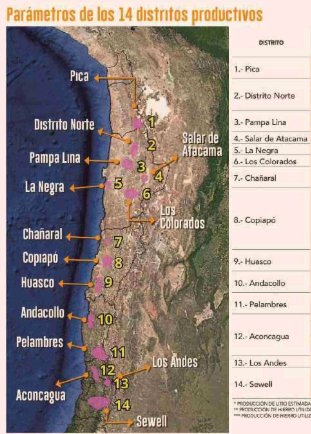
Chile has established itself as a global leader in mining, most notably in the production of copper and lithium. The mining sector has developed into a cornerstone of the country’s economy, accounting for a significant portion of the country’s GDP and export revenues. In recent years, the government has implemented various initiatives to enhance efficiency and attract foreign investment. For example, the District-Based Mining Strategy, which is designed to centralise mining operations within designated districts to encourage economic growth, improve infrastructure and optimise resource extraction.
This article takes a look at Chile’s District-Based Mining Strategy, exploring its advantages, potential challenges and investment prospects for foreign investors.
Understanding the District-Based Mining Strategy
District-based mining promotes a regional, district-specific approach to mining, promoting the development of mining districts which are tailored to specific regional characteristics. There are two variations of mining districts known as mining hotspot districts and secondary mining districts. Both are located mainly in the northern regions of the country, most notably the Region of Antofagasta and Atacama. One of the most significant differences between the two groups is the number of investments that each group has received in the last decade. Mining hotspot districts experienced nearly eight times more mining investment per district than secondary districts, with the latter focusing more on smaller scales of mining projects and older investments.
Some of Chile’s most important mines are located in the Tarapacá Region. This location is advantageous since it allows connectivity by port and highways to the North of Chile, South of Peru and Bolivia. It also has a tax advantage in two free trade zones and is exempt from custom duties and taxes. The Antafogasta region plays an important role in the mining industry, being home to several suppliers and universities specialised in mining-related research and contributing to over 70% of the country’s GDP.
SONAMI, Chile’s National Mining Society, is a key association that promotes the Chilean mining sector and maximising the potential of specific areas. The district-based mining concept focuses on the support of mining operations within certain districts that have mining potential, encouraging cooperation between private companies, the government and local stakeholders. SONAMI highlights the importance of developing mining resources that are geographically concentrated in certain areas, assuring that mining benefits are distributed locally and continue to contribute to regional economic growth. The recent alliance between Codelco and Anglo American to join their Andina and Los Bronces operations has encouraged SONAMI to propose a structural change- promoting the concept of ‘productive districts’ as a form of collaborative mining. SONAMI emphasises the value of supporting initiatives, research and technologies that enhance local operations to support regional businesses and services to stimulate local economies. This includes strengthening the local mining supply chain through investing in transportation and logistics. In some districts, SONAMI supports small-scale mining, something that has become a significant source of income for local communities.
Public-Private Collaboration
Recently, there has been a rise in innovative public-private partnerships which have played a key role in the mining industry’s development. The recent partnership between Codelco, Chile’s state-owned copper mining company and Anglo American, a multinational mining corporation, is a useful case study to demonstrate the advantages of such collaborations, benefitting both domestic and foreign investors. A joint mine plan was created for their adjacent Los Bronces and Andina copper mines, with the collaboration aiming to increase copper production with minimal additional investment. This demonstrates how well-designed mining districts can produce substantial economic gains, making Chile appealing to foreign investors. This partnership also places a strong emphasis on sustainability, which is a fundamental component of the plan.
Investment Opportunities
It is notable that Chile offers financial incentives to support project development. Chile’s tax regime is renowned for being relatively favorable towards mining companies, including tax exemptions for certain areas, as discussed above. In 2020, a mining royalty was implemented in an attempt to grant greater autonomy to regions.
Opportunities for Small Suppliers
SONAMI’s District-Based Mining Strategy presents significant opportunities for smaller suppliers as it encourages a more integrated and collaborative mining ecosystem. Through maintaining a focus on regional districts, a more accessible environment for local businesses which are part of the mining supply chain.
The expansion of supplier networks within mining districts is a key opportunity for small suppliers since they are encouraged to establish long-term partnership with larger firms. This strategy also ensures that small businesses receive support in the form of training and financing to help them meet industry standards. Moreover, the sustainability focus of the strategy creates opportunities for suppliers with a focus on eco-friendly products and services.
Sustainability, Water Use, and Social Impact
As mentioned above, the District-Based Mining Strategy recognises that the mining sectors must balance economic growth with environmental responsibility and places an emphasis on sustainability. As a result of increasing concerns over water scarcity and resource depletion, the strategy advocates mining as a long-term, responsible driver of development.
Sustainability and Environmental Responsibility
Sustainability has become a core element of the strategy, with more companies adopting cleaner technologies and better waste management practices. Companies are also encouraged to implement renewable energy sources, such as solar or wind power to reduce the use of fossil fuels. As a result, Chile’s mining industry becomes more attractive to responsible investors since it demonstrates compliance with global sustainability standards.
Water Use and Management
In arid regions such as the Atacama Desert, water scarcity is a challenge that mining operators face. The strategy promotes the use of desalination plants, which convert seawater into freshwater for industrial use rather than relying on natural water sources. Recycling and reusing water within mining processes is encouraged, minimising consumption and waste.
Social Impact and Community Engagement
In order to ensure that local populations benefit from mining operations rather than experiencing resource depletion or displacement, a sustainable mining sector must also consider its social impact. This approach places a strong emphasis on stakeholder input and community participation, encouraging open communication between local governments, mining firms, and Indigenous people. The mining industry may support social stability and economic development by giving local employment priority and incorporating communities in decision-making processes. Another important component of the strategy’s social focus is investment in infrastructure, training, and education. In order to guarantee that locals have access to good job prospects, mining companies are urged to promote the growth of the local workforce through skills training initiatives. Roads, schools, and medical facilities are examples of infrastructure investments that help nearby communities over the long run.
SONAMI’s District-Based Mining Strategy guarantees that Chile’s mining industry maintains its competitiveness while adhering to international environmental and social norms by combining sustainability, responsible water use, and social participation.
The Role of Copper in a Decarbonized Economy
Due to the global shift away from fossil fuels, the demand for copper is expected to rise significantly, positioning Chile at the centre of this change. Copper will play an increasingly important part in the green transition as the need for low-carbon technologies increases. Chile can help a cleaner, more energy-efficient world and solidify its place as a global leader in responsible mining by committing to sustainable copper production.
Copper in Renewable Energy
The demand for a steady and sustainable supply of copper will rise alongside investments in renewable energy. This is because wind turbines, solar panels and energy solar systems rely on large amounts of copper for their generators and wiring due to its conductivity and durability.
Electric Vehicles and Green Transportation
With EVs needing up to four times as much copper as conventional gasoline-powered vehicles, the transportation sector is rapidly electrifying. The extensive use of clean transportation is made possible by copper, which is an essential component of electric motors, batteries, and charging infrastructure. Copper’s significance in enabling an emissions-free mobility system is further supported by the advancement of smart grids and effective charging stations.
Energy Efficiency and Circular Economy
Copper is a key component of the circular economy due to its strong recyclability. It is incorporated into power grids, industrial systems, and energy-efficient buildings to assist lower energy use and boost global decarbonisation initiatives.
To maximise Investment Opportunities for Foreign Stakeholders
By utilising Chile’s abundant mineral resources, well-established infrastructure, and dedication to sustainability, SONAMI’s District-Based Mining Strategy offers attractive investment options for international stakeholders. Chile, a major producer of copper and a centre for lithium mining, provides a solid regulatory framework and policies aimed at luring FDI (foreign direct investment).
How Becker Abogados Supports Foreign Investors in Chile’s Mining Ecosystem
To help international investors seize the momentum created by Chile’s new mining districts, Becker Abogados offers tailored legal solutions that make market entry fast, safe, and compliant. Our services include obtaining an investor RUT, fast-track company formation, contract review and drafting, legal risk reports, and project feasibility evaluations. We also specialise in Chilean labor law—advising on employee hiring, preparing mandatory internal regulations, handling union negotiations, preventing costly lawsuits, and resolving employment disputes efficiently. These services help protect our clients’ reputations and operational margins by minimising legal risks and ensuring full regulatory compliance from day one.
Focused Investment in Important Mining Areas
Targeted investments in areas with significant mineral potential, such Tarapacá, Atacama, and Antofagasta, which have large reserves of copper and lithium, are advantageous to foreign investors. These regions already have advanced energy grids, port infrastructure, and transportation networks, which lower operating risks and guarantee effective supply chain operations. As a result, these are more attractive to international investors. The government offers tax benefits and public-private partnerships to attract investment in key mining regions.
To conclude, the District-Based Mining Strategy proposed by SONAMI promotes technological innovation, regional cooperation, and new prospects for foreign investors and small suppliers. Along with addressing important issues including environmental damage and water scarcity, the strategy encourages the use of renewable energy sources and sustainable resource management.









